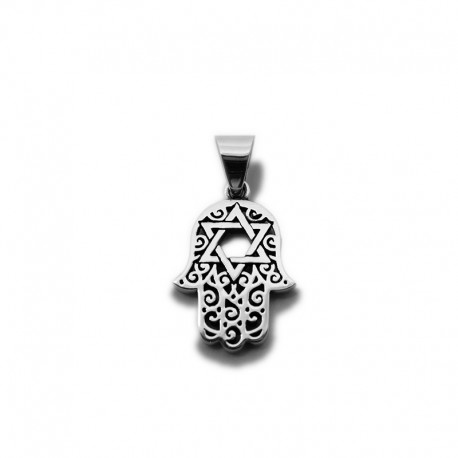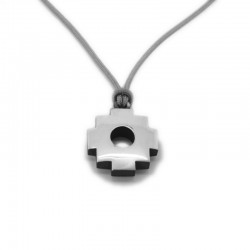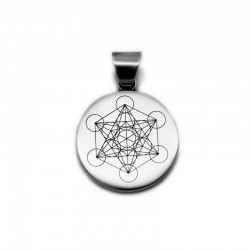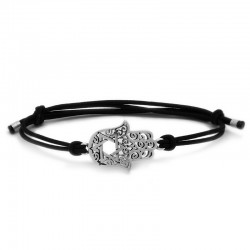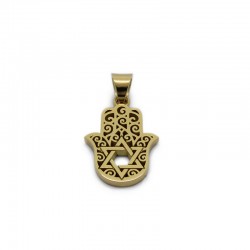No products
Silver Hand of Fatima Necklace
Sterling silver
Hand of Fatima necklace, also known as Hamsa or Khamsa: a very popular protective amulet in Islam and Judaism, especially in the Middle East and North Africa. It is a symbol in the shape of a hand with outstretched fingers, often combined with other symbols included in the palm of your hand. Believers wear it against the evil eye, bad energies, and misfortune, to attract good luck and fortune, and generally as a talisman of protection and blessing.
Sterling silver. You can choose whether you want the Hand of Fatima facing up or down. And you can choose the finish: cotton cord, silver ring, or silver chain.
Exclusive design true to the original and 100% handmade. No tricks: what you see in the photo is the exact treasure you will receive at home.
MeriTomasa exclusive packaging included + International Shipments with DHL.
And if you like it but would prefer it with some changes... please tell me and we will talk about it :)
30 Items
Data sheet
| Collection | Hand of Fatima |
| Category | Necklaces |
| Material | Sterling silver |
| Height | 21mm |
| Width | 17mm |
| Thickness | 2mm |
More info
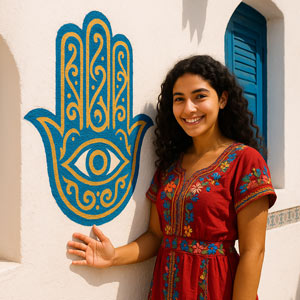 A young Tunisian woman in front of her house, with a Hamsa painted on the wall to attract good fortune and as a protective talisman.
A young Tunisian woman in front of her house, with a Hamsa painted on the wall to attract good fortune and as a protective talisman.The hamsa or khamsa is a symbol in the shape of an open hand, very popular in various cultures of the Middle East and North Africa. Its name comes from the Arabic word خمسة, romanized "khamsa", which means "five", referring to the five fingers of the hand. Its origins are lost in time and are intertwined with several ancient cultures of the Mediterranean and the Middle East. Although today it is primarily known for its association with Islam and Judaism, its roots are much older and probably pre-religious:
Mesopotamia and Carthage (centuries before our era): The hand symbol already appears on amulets and sculptures from these civilizations. In Carthage, it was linked to the goddess Tanit, a female deity who protected life and fertility.
Ancient Egypt: The open hand was also used as a sign of magical protection, similar to the Eye of Horus.
Phoenician and North African cultures: It was a symbol of divine femininity and was used to invoke maternal protection.
In Islam, the Hamsa becomes the Hand of Fatima, in honor of Fatima al-Zahra, daughter of the prophet Muhammad. It represents faith, patience, and protection. The five fingers symbolize the five pillars of Islam.
In Judaism, the Hamsa is known as the Hand of Miriam, sister of Moses and Aaron. It represents divine protection, especially against the evil eye, and the five fingers are associated with the five books of the Torah.
Over time, the Hamsa has transcended religions and cultures. Today it is used in pendants, door hangers, tattoos, and decorative art as a symbol of protection, inner peace, and good energy.
In short, the Hamsa is an ancient and powerful symbol that has survived thousands of years because it speaks a common language: that of the human desire for protection, faith, and blessing.
Upward or downward?
You've probably seen that the Hand of Fatima can be oriented upward or downward. But... what does each mean?
- Hand of Fatima upward:
- Meaning: It is interpreted as a symbol of protection and blessing.
- Purpose: The hand indicates power and strength. It is used to ward off the evil eye and negative energies, and to attract good luck and fortune.
- Hand of Fatima facing down:
- Meaning: Some people see it as a symbol to disperse negative energy towards the earth.
- Purpose: It is used to dispel bad influences and tensions away from the wearer and is considered a magnet to attract good luck, patience, and love.
What is the legend of the Hand of Fatima?
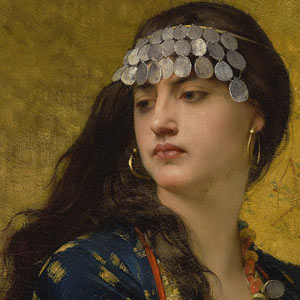 Fatima az-Zahra, painted by Jules Lefebvre in 1883.
Fatima az-Zahra, painted by Jules Lefebvre in 1883.The legend of the Hand of Fatima has its roots in Arab lands, woven between history and devotion. Its protagonist is Fatima az-Zahra, daughter of the prophet Muhammad and his first wife, Khadija, a wise and strong woman. Fatima was the prophet's only surviving daughter, and is considered by Shia Muslims to be the spiritual mother of believers, a symbol of purity, sacrifice, and faith.
Fatima grew up in a home marked by faith and spiritual struggle. Her life was discreet but deeply meaningful, reflecting a total dedication to the values of family, religion, and community. She married Ali ibn Abi Talib, cousin of the prophet Muhammad and one of the most important figures in Islam. Together, they had children who would also become key figures in Islamic history, such as Hassan and Hussein.
Despite the love that united Fatima and Ali, seventh-century Arab society permitted polygamy. One day, Ali returned home with the news that he had taken a second wife. Fatima's devotion to him was so profound that the news fell upon her like a silent dagger. Her heart, which had always beaten to the rhythm of duty and faith, was torn apart by silent pain.
They say that that very day, Fatima was preparing a stew on the hearth. In the midst of her grief, her mind wrapped in sadness, she began to stir the boiling pot. So profound was her sorrow that she didn't feel the heat embrace her skin. She put her bare hand into the stew and stirred without a single complaint, as if the pain of her body anesthetized the pain of her soul. Ali, upon entering and seeing that scene, was paralyzed. The image of his wife, noble and silent, enduring the heat of the fire without a gesture, pierced him with guilt.
Moved to tears, he approached tenderly, gently took her burned hand, and begged her forgiveness. He understood the harm he had caused, not out of imposition, but out of love. In an act of sincere repentance, he dismissed his other wife and promised never to hurt her again. Fatima, with her characteristic dignity, accepted his promise, not out of weakness, but out of the strength of her faith and her steadfast heart. Since then, the image of the open hand—the hand that cooks, that blesses, that silently endures pain—became a symbol of protection, feminine strength, and compassion. The Hand of Fatima represents the silent resilience of women, spiritual fidelity, true love, and the power of faith that heals.
What is the legend of the Hand of Miriam?
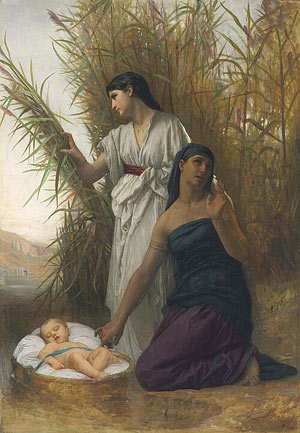 Moses among the reeds, with his mother and his sister Miriam, who watches over him, painted by Elizabeth Jane Gardner.
Moses among the reeds, with his mother and his sister Miriam, who watches over him, painted by Elizabeth Jane Gardner.Miriam was the older sister of Moses and Aaron, and a key figure in the history of the people of Israel. She was not only a loving sister, but also a courageous prophetess and spiritual leader, renowned for her wisdom, vision, and steadfastness in times of adversity. He was born in Egypt, at a time of great suffering for the Hebrews, enslaved under the rule of Pharaoh.
When Moses was born, Pharaoh, fearful of the growth of the Israelite people, ordered the murder of all Hebrew male babies. It was a cruel and ruthless decree, designed to eliminate any possibility of future resistance. Moses' mother, Jochebed, decided to protect her son at the risk of everything: she placed the little boy in a papyrus basket sealed with tar and entrusted him to the waters of the Nile, hoping the current would carry him to a safer destination.
But she didn't leave it to chance. Miriam, still just a child, volunteered to watch over her brother from the riverbank. Hidden among the reeds, she followed the basket with a steady gaze, driven by unconditional love and a maturity surprising for her age. She watched as Pharaoh's daughter found the child, and with great cunning, she approached to offer him a Hebrew wet nurse: her own mother. Thanks to her intervention, Moses was able to be raised by his true family during his early years.
Miriam not only saved her brother that day. Years later, she would also become a leader alongside Moses and Aaron during the exodus of the people of Israel. It was she who, after the miraculous crossing of the Red Sea, took up the drum and sang songs of freedom alongside the Hebrew women, celebrating their liberation from slavery with joy and faith. Her figure represents guidance, spiritual vision, and the feminine strength that sustains and encourages the people in times of crisis.
Over time, her protective and visionary role became a symbol. Thus was born the legend of the Hand of Miriam, represented as an open hand, also known as Hamsa. This symbol was adopted as an amulet of protection, hope, and blessing, especially in the Jewish tradition of North Africa and the Middle East.
The Hand of Miriam symbolizes more than mere physical protection: it represents active vigilance, unwavering faith, and feminine protection filled with wisdom and courage. Each finger of the hand can be understood as a virtue: love, faith, strength, compassion, and justice.
But... if Jews and Muslims get along so badly, how can they share symbols like the Hamsa?
Although there have been many conflicts between Jews and Muslims throughout history, it is also true that they share many cultural, historical, and religious roots. That's why they share traditions like the hamsa, despite the tensions:
Common origins: Both Judaism and Islam have roots in the Middle East and share many stories, characters, and beliefs that come from ancient traditions, including monotheism and biblical figures like Abraham and Moses.
Cultural exchange: For centuries, especially in places like Al-Andalus, Egypt, and the East, Jews, Muslims, and Christians lived together and shared ideas, art, symbols, and customs, which generated an intense cultural mix.
Universal symbolism: The hamsa, as a symbol of protection, good luck, and the ward off evil, has a meaning that transcends religions. Many cultures use similar amulets because they represent a common human need: protection from negativity.
What does the Hand of Fatima combined with the Fleur-de-lis and the Star of David mean?
The combination of the Hand of Fatima with the Fleur-de-lis can have various meanings depending on cultural and personal perspective, but the most common ones relate to:
- Protection and nobility: The Hand of Fatima, on its own, is a symbol of protection, and the Fleur-de-lis has historically been associated with nobility and royalty. In this context, the combination represents the protection of noble and high values.
- Balance and spirituality: Some people view the Hand of Fatima as a symbol of spiritual protection and the Fleur-de-lis as a symbol of balance and spiritual perfection. Together, they represent the search for harmony and protection in the spiritual realm.
- Cultural Heritage: The combination of the Hand of Fatima with the Fleur-de-lis also reflects a blend of cultural heritages. For example, it can symbolize the connection between the spiritual protection of the Hand of Fatima in Arab culture and the symbolism of the Fleur-de-lis in European culture.
In addition, the combination of the Hand of Fatima with the Star of David also has various meanings:
- Union of Cultures: The Hand of Fatima is commonly associated with Arab culture and Islam, while the Star of David is an important symbol in Jewish culture. The combination of both symbols can represent the union of different cultures or even harmony between different religions.
- Protection and Spirituality: Both symbols, separately, are considered protective amulets in their respective cultures. The Hamsa protects against the evil eye, and the Star of David is an important symbol in Judaism. Together, they can symbolize broad protection and spiritual connection.
- Search for Balance: Some people interpret the combination of the Hand of Fatima and the Star of David as a symbol of balance and harmony in life. It represents the search for peace and unity amidst different influences and beliefs.
- Personal expression: For those who wear jewelry that combines these symbols, it is a personal expression of their own beliefs and values, without necessarily adhering to a specific cultural or religious interpretation.
So... there is no single interpretation, nor is one that is right and the other wrong... The meaning can vary depending on the person wearing it and the context in which it is presented. Jewelry and personal symbols often have individual meanings and can be expressions of unique identity and spirituality...
...So I leave the final interpretation up to you :)
Why buy your Hand of Fatima at The MeriTomasa's Treasures Factory?
 Yo misma, en mi taller de joyería artesanal de La Fábrica de Tesoros de MeriTomasa.
Yo misma, en mi taller de joyería artesanal de La Fábrica de Tesoros de MeriTomasa.I am neither a magician nor a priestess. I am not a specialist in the Jewish religion or in the Christian religion. Neither in the Bible nor in the Torah. Neither in mysticism nor in Kabbalah. Nor am I a specialist in esotericism, magic or the occult. I'm a jeweler. That's why I rarely talk about the benefits and uses of the Hand of Fatima on my website. My mission is not to explain to you how and when and why of these treasures that unite religion and worldview, nor do I want to convince you to use them as an amulet or talisman. If you have reached this page, perhaps you know more about the subject than I do, and according to my experience, each client expects a different use or benefit from my treasures..
As a jeweler, my mission is to offer you top quality treasures both in relation to the metal that makes them up and in relation to the design, modeling and finishing process. That is why I adhere to campaigns such as Fashion Revolution or I presume to be accredited with the craft product badge (D’A).
My mission as a jeweler is to offer you treasures such as Hand of Fatima in the form of top quality jewels, both in relation to the precious metals that make them up and in relation to the design, modeling and finishing process. And also, do it from craftsmanship and humility. I do not manufacture in series in distant countries and I do not sell wholesale: I offer you handmade jewelry with international shipments and at fair prices.
On the other hand, it is true that I am very interested in the subject of personal growth and I have taken courses on channeling positive energies, so that both from the point of view of a jeweler and from the point of view of personal growth, I have been designing and modeling for years treasures of sacred and esoteric jewelry, and I have made an effort to document its design and optimal manufacturing process. One of my best-selling treasures is the Atlantis Ring. Some of my clients have also asked me about the Tetragrammaton or the Hand of Fatima for a long time, and finally, after much work on it, I have decided to offer it to you with an exclusive design faithful to the original sacred design.
In addition, now I have a quality certificate that makes me very happy: my first six years at The MeriTomasa's Treasures Factory, the result of the trust of many clients like you. Thank you everyone!
The MeriTomasa's Treasures Factory is specialized in custom made jewelry for all tastes and budgets: wedding rings, headbands, earrings, pendants, brooches, bracelets, rings, tiaras... My value proposition is to create quality jewelry, designed and manufactured by hand, with a focus on personalization. That is why I join campaigns like Fashion Revolution or I amb proud of being accredited with the craft product (D'A) distinctive, which certifies that my jewelry is of own production and they are made by hand using the processes of my trade and produced in my workshop in Manresa, kilometer zero. I offer a more intimate, romantic, exclusive and quality jewelry.
Many of the pieces that you will find on my website could be included as sacred jewelry or esoteric jewelry. It was not my first intention when I opened The MeriTomasa's Treasures Factory. But I have the feeling that some of those treasures, such as the Atlantis Ring or the Chakana Collection, and Tetragrammaton and now Hand of Fatima , have come to me to offer me paths to grow, and I have walked those paths with all humility and giving thanks for every little challenge that the twists and turns of the road have offered me.
Like all my pieces, my Hand of Fatima Collection is designed and modeled in my workshop in Manresa (Barcelona), from personalized jewelery orders since 2006, so that you can boast of wearing a zero kilometer jewel of artisan manufacture.
And if you like it but would prefer it with some changes... please tell me and we will talk about it :)

